I love the ocean and I love the mountains, but nothing has a stronger pull on me than the desert. I've long tried to figure out why, and I think it has to do with getting away from people, being in the middle of a vast, empty landscape, and hearing nothing but silence.
It's only fitting then that the first destination on my recent San Diego trip was Anza-Borrego Desert State Park (ABDSP). Located northeast of San Diego (see map) in the Colorado Desert, it's enormous: almost 600,000 acres. That makes it the largest state park in California. The park is named after 18th century Spanish explorer Juan Bautista de Anza and the Spanish word for bighorn sheep, borrego.

I spent the night in the small community of
Borrego Springs, which is completely surrounded by ABDSP. As small as it is, Borrego Springs has quite a variety of places to stay and eat; not surprising, given that the area is a popular weekend destination for people from San Diego and Palm Springs. It is one of the first
Dark Sky Communities in the U.S. where nighttime lighting is kept to a minimum in order to maximize stargazing. I arrived after dark, and it was indeed odd—but at the same time oddly exciting—to see an entire town so dim. (To get an idea of what the night sky looks like in Anza-Borrego,
check out these amazing photos.)
The next morning, I got up early with a very specific goal—see this in the dawn light:
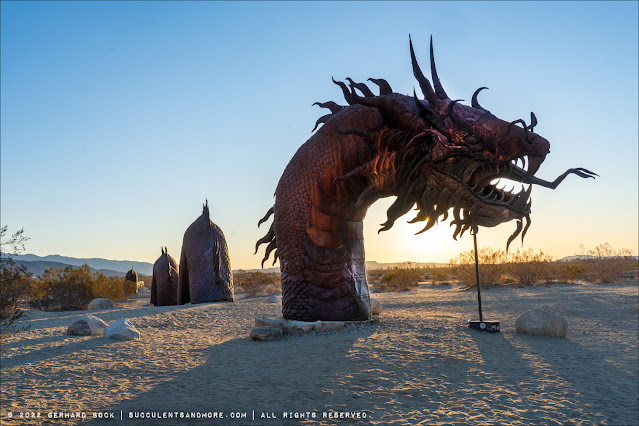 |
| The Serpent |
If you've been to Borrego Springs in the last 10+ years, you will have noticed massive metal sculptures depicting everything from prehistoric creatures to modern-day farm workers scattered over a large expanse of land north and south of town. They were created from 2008 to 2012 by
Ricardo Breceda, a former construction worker who started to make metal art after an accident left him unable to continue in his previous job. When Borrego Springs landowner Dennis Avery, an heir to the
Avery label fortune, discovered Breceda's work, he commissioned him to design sculptures based on the 2006 book
Fossil Treasures of the Anza-Borrego Desert. They were installed in
Galleta Meadows Estate, multiple parcels of land Avery owned in Borrego Springs. Today, the land is managed by the Under the Sun Foundation and open to foot traffic.
In addition to prehistoric animals originally found in the Anza-Borrego desert, Breceda created sculptures of mythical creatures as well as historic personas, including a Native American chief, a Spanish friar, a gold miner, and migrant farm workers. All in all, Breceda constructed 131 sculptures installed at 28 sites in Borrego Valley.
 |
| One of Breceda's best-known sculpture is The Serpent, a 350-foot long creature with the head of a Chinese dragon, the body of a sea serpent, and the tail of a rattlesnake |
 |
| Borrego Springs Road bisects the serpent (see red car in the photo above) |
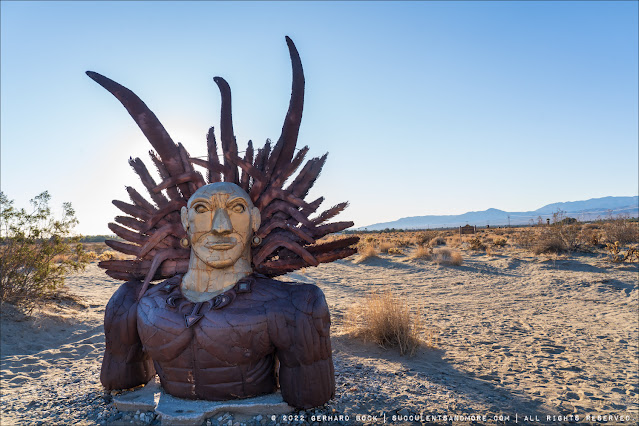 |
| Indian Head, representing the chief of the Yuma at the time of Spanish explorer Anza's arrival at the Colorado River in 1774 |
 |
| Spanish Padre, representing the spiritual leaders of Anza's 1775-76 California expeditions |
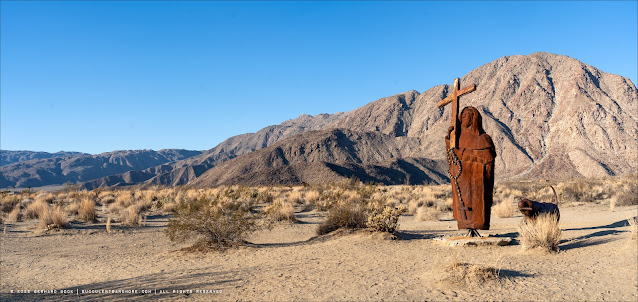 |
| Spanish Padre and his loyal dog |
 |
| Gold Miner and Mule |
 |
| Gold Miner and Mule |
 |
| Jeep, representing the 1946 Willys CJ-3A, the first full-production civilian Jeep. It opened up desert exploration to regular folks. |
 |
| Jeep |
 |
| Gracile Sabertooth Cat and Extinct Horse |
 |
| Columbian Mammoth |
 |
| Extinct Horses in the distance |
Before I knew it, 2½ hours had gone by, and I'd only photographed a couple of dozen sculptures. Some are right by the road, but others are a bit further afield. One of these days, I want to spend a couple of days in Borrego Springs and try to see them all. This foldout
Quick Guide to Sky Metal Sculptures in Borrego Valley lists the best-known sculptures; a Kindle ebook called
Metal Sculptures of Borrego Valley contains detailed information on all 131 sculptures.
 |
| A lone California barrel cactus (Ferocactus cylindraceus) poignantly underscores the vastness of the desert |
 |
| Teddy bear cholla (Cylindropuntia bigelovii) |
Anza-Borrego is home to the aptly named Agave deserti, one of three agave species endemic to California (Agave shawii and Agave utahensis being the other two). Agave deserti grows in large numbers all over Anza-Borrego. It may not be the most attractive species, but I was thrilled nonetheless to see it in its native habitat. The photo below was taken at the Visitor Center of Anza-Borrego Desert State Park (ABDSP):
 |
| Agave deserti |
 |
| The ABDSP Visitor Center is built into surrounding landscape. It's completely invisible from the parking lot; all you can see is a slight rise with desert plants growing on it. |
 |
| A desert garden outside the Visitor Center has labeled specimens of many plants found in the park. It's well worth a stroll. |
As I mentioned, ABDSP is enormous. It has 500 miles of dirt road and who knows how many hiking trails, official and unofficial. I'm not a hiker, but I did want to see the native cacti in habitat so I chose the aptly named
Cactus Loop Trail. It has about a dozen numbered markers interpreting features and plants of interest; they're explained in a pamphlet available for free at the trailhead. Typical of most other trails in ABDSP, this not a manicured (or even clearly demarcated) trail, but rather a scramble over rocks and through desert vegetation. Maybe that was the reason why I enjoyed it so much, in spite of the extra attention the uneven terrain required.
The photos below give you a pretty good idea of what you get to see:
 |
| Teddy bear cholla (Cylindropuntia bigelovii) and strawberry hedgehog (Echinocereus engelmannii) |
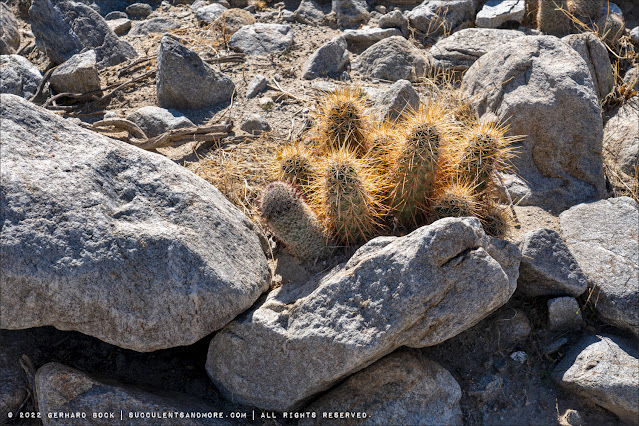 |
| Strawberry hedgehog (Echinocereus engelmannii) |
 |
| Strawberry hedgehog (Echinocereus engelmannii) |
 |
| California fishhook cactus (Mammillaria dioica) |
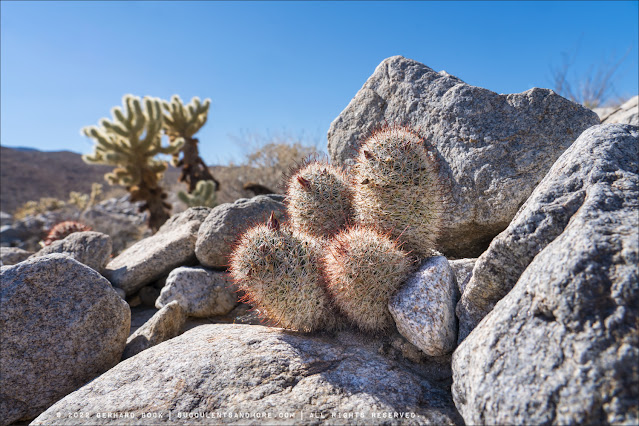 |
| California fishhook cactus (Mammillaria dioica) |
 |
| California fishhook cactus (Mammillaria dioica) |
 |
| California barrel cactus (Ferocactus cylindraceus, syn. Ferocactus acanthodes) |
 |
| Chuparosa (Justicia californica) and California barrel cactus (Ferocactus cylindraceus) |
 |
| Teddy bear cholla (Cylindropuntia bigelovii) |
 |
| Teddy bear cholla (Cylindropuntia bigelovii) with an emerging flower |
 |
| I know that cairns are frowned upon in certain circles, but I appreciated the occasional confirmation that I was still on the right track |
A few more photos of plants in ABSDP:
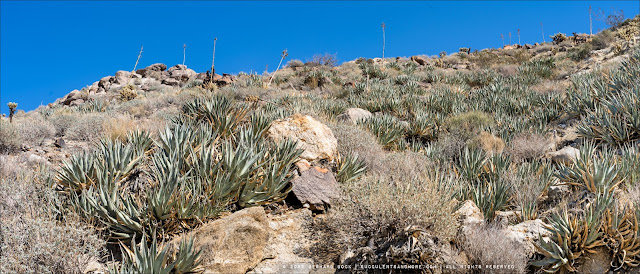 |
| Agave deserti by the thousands |
 |
| Agave deserti |
 |
| Agave deserti |
 |
| Creosote bush (Larrea tridentata) |
If the winter and spring rainfalls are sufficient and properly timed, Anza-Borrego puts on an impressive wildflower display beginning in late February.
This website shows most of the wildflower species native to the area. It doesn't look like 2022 will amount to much, however. Other than chuparosa (
Justicia californica), which you saw in a photo further up in this post, the only wildflower I saw was this thick-leaf ground cherry:
 |
| Thick-leaf ground cherry (Physalis crassifolia) |
I didn't come looking for wildflowers so I wasn't disappointed. What I wanted to see were panoramic desert vistas, and they are everywhere:
As I mentioned, Anza-Borrego is in the
Colorado Desert, the northwestern section of the
Sonoran. As a low-elevation desert, it experiences extreme summer temperatures (a record of 122°F was recorded in Borrego Springs on June 20, 2016) but almost never sees frost. On the day of my visit, February 9, 2022, the daytime high was an unseasonable 87°F. That was plenty toasty for me; I wouldn't want to visit any later than, say April.
RELATED POSTS:
© Gerhard Bock, 2022. All rights reserved. To receive all new posts by email, please subscribe here.









































So interesting. Thanks for taking us, Gerhard. I've read about Anza-Borrego but seeing so much is terrific!
ReplyDeleteI only scratched the surface. There's so much to see in Anza-Borrego, including a slot canyon. But I didn't feel comfortable on dirt roads in my Toyota Camry; it has so little clearance.
DeleteThe Miner and Mule are fun, but the Serpent is spectacular!
ReplyDeleteSeeing nothing but open vistas and blue sky is very special and healing; good for meditation if one is inclined. The vastness of the night's sky, sparkling with stars must also be and amazing experience, something city dwellers can hardy even imagine.
I was so tired when I got there that I went straight to bed. Next time, I'll try to have a more relaxed schedule so I can really enjoy the night sky.
DeleteAs usual, you made great use of your visit. I've never seen the sculptures in Anza-Borrego, having only made a short stop there years ago during a superbloom. I'm not surprised you didn't see much in the way of flowers this year, given how dry we've been.
ReplyDeleteYeah, no chance for a good wildflower display this year. Even the California poppies aren't their usual excuberant selves.
DeleteWOW! That was fantastic. I miss the desert.
ReplyDeleteI really needed a desert fix :-)
DeleteI just returned from visiting Anza-Borrego. It was mighty hot (100+ during the day). We could hike only from 6-8 am and even then it was already pushing it. So many succulents and cacti all in one place. It was very rewarding and I hope to go back when it's cooler and I can spend more time.
ReplyDelete